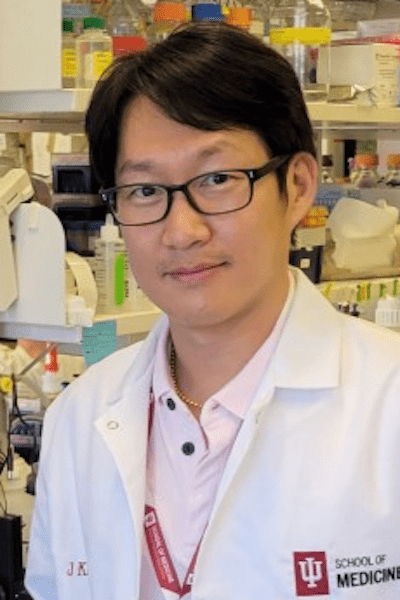
Byungwook (BK) Kim, PhD
Assistant Research Professor of Medical & Molecular Genetics
MS
- Phone
- (317) 278-6353
- Address
-
NB 108
MMGE
IN
Indianapolis, IN - PubMed:
-

Bio
Dr. Kim earned his MS degree in 2010 and completed his PhD in 2014, both from KonKuk University in Korea. During his predoctoral training, he investigated the development of immune-based therapeutics to treat neuroinflammation and neurodegenerative diseases, with a particular focus on Parkinson's disease (PD). During his initial postdoctoral training in Korea, his research continued to focus on neuroinflammation and glia-mediated pathogenesis in PD. In this role, he conducted research utilizing post-mortem brain tissues from PD patients and mouse models of PD, including neurotoxin models such as 1-methyl-4-phenyl-1,2,3,6-tetrahydropyridine (MPTP) and 6-hydroxydopamine (6-OHDA).
In 2016, Dr. Kim joined Dr. Jungsu Kim's laboratory at the Mayo Clinic in Jacksonville, Florida, as a postdoctoral researcher. This move allowed him to broaden his expertise in neurodegenerative diseases by shifting his focus to Alzheimer's disease (AD) research. He then transitioned with Dr. Jungsu Kim's laboratory to the Stark Neurosciences Research Institute at the Indiana University School of Medicine in 2018.
Dr. Byungwook Kim now serves as an Assistant Research Professor in the Department of Medical and Molecular Genetics at the Indiana University School of Medicine. His current research endeavors are dedicated to understanding the roles of microRNAs, the AD genetic risk factor SPI1, and lipid-regulating proteins in the pathogenesis of AD.
Key Publications
Al-Amin MM, Kim B, Karahan H, et al. (2025) Apolipoprotein ε4 exacerbates white matter impairment in a mouse model of Aβ amyloidosis by decreasing actively myelinating oligodendrocytes. Alzheimer's & Dementia. 21(10):e70791. https://doi.org/10.1002/alz.70791
Cho DY, Han JH, Kim IS, et al. (2025). The acetyltransferase GCN5 contributes to neuroinflammation in mice by acetylating and activating the NF-κB subunit p65 in microglia. Sci Signal. 2025 Mar 4;18(876):eadp8973. (*Co-Corresponding author) https://www.science.org/doi/abs/10.1126/scisignal.adp8973
Tate M, Wijeratne HRS, Kim B, et al. (2024). Deletion of miR-33, a regulator of the ABCA1-APOE pathway, ameliorates neuropathological phenotypes in APP/PS1 mice. Alzheimers Dement. 2024 Nov;20(11):7805-7818. https://doi.org/10.1002/alz.14243
Dabin LC$, Kersey H$, Kim B, et al. (2024). Loss of Inpp5d has disease-relevant and sex-specific effects on glial transcriptomes. Alzheimers Dement. 2024 Aug;20(8):5311-5323. https://doi.org/10.1002/alz.13901
Kim B, Dabin LC#, Tate MD#, et al. (2024). Effects of SPI1-mediated transcriptome remodeling on Alzheimer’s disease-related phenotypes in mouse models of Aβ amyloidosis. Nat Commun. 2024 May 11;15(1):3996. https://doi.org/10.1038/s41467-024-48484-x
Lancaster MS, Kim B, Doud EH, et al. (2023). Loss of succinyl-CoA synthetase in mouse forebrain results in hypersuccinylation with perturbed neuronal transcription and metabolism. Cell Rep. 2023 Oct 31;42(10):113241. https://doi.org/10.1016/j.celrep.2023.113241
Acri DJ, You Y, Tate MD, et al. (2023). Network analysis identifies strain-dependent response to tau and tau seeding-associated genes. J Exp Med. 2023 Nov 6; 220(11): e20230180. https://doi.org/10.1084/jem.20230180
Karahan H, Smith DC, Kim B, et al. (2021). Deletion of Abi3 gene locus exacerbates neuropathological features of Alzheimer's disease in a mouse model of Aβ amyloidosis. Sci Adv. 2021 Nov 5;7(45):eabe3954. https://pubmed.ncbi.nlm.nih.gov/34731000/
Kim B$, Park JY$, Cho DY$, et al. (2020) 2-(5-(4-Chlorophenyl)-1-(2,4-dichlorophenyl)-4-methyl-1H-pyrazol-3-yl)-N-(2-hydroxyethyl)-2-oxoacetamide (CDMPO) has anti-inflammatory properties in microglial cells and prevents neuronal and behavioral deficits in MPTP mouse model of Parkinson's disease. Neuropharmacology. 2020 Apr;166:107928. https://www.ncbi.nlm.nih.gov/pubmed/31887307
Ganesan P$, Kim B$, Ramalaingam P$, et al. (2019) Antineuroinflammatory Activities and Neurotoxicological Assessment of Curcumin Loaded Solid Lipid Nanoparticles on LPS-Stimulated BV-2 Microglia Cell Models. Molecules. 2019 Mar 25;24(6):1170. ($Co-first author) https://www.ncbi.nlm.nih.gov/pubmed/30934561
Kim BW, Jeong KH, Kim JH, et al. (2016) Pathogenic upregulation of glial lipocalin-2 in Parkinsonian dopaminergic system. J Neurosci. 36(20):5608-22. http://www.ncbi.nlm.nih.gov/pubmed/27194339
Kim BW, Sandeep M, Yun YS, et al. (2016) A novel synthetic compound MCAP suppresses LPS-induced murine microglial activation in vitro via inhibiting NF-kB and p38 MAPK pathways. Acta Pharmacol Sin. 37:334-43. http://www.ncbi.nlm.nih.gov/pubmed/26838070
Kim BW, Koppula S, Kumar H, et al. (2015) α-Asarone attenuates microglia mediated neuroinflammation by inhibiting NF-?B activation and mitigates MPTP-intoxicated behavioral deficits in a mouse model of Parkinson’s disease. Neuropharmacology. 97:46-57. http://www.ncbi.nlm.nih.gov/pubmed/25983275
Kim BW, Koppula S, Park SY, et al. (2015) Attenuation of neuroinflammatory responses and behavioral deficits by Ligusticum officinale (Makino) Kitag in stimulated microglia and MPTP-induced mouse model of Parkinson?s disease. J Ethnopharmacol. 164:388-97. http://www.ncbi.nlm.nih.gov/pubmed/25449453
Kim BW, Koppula S, Park SY, et al. (2014) Attenuation of inflammatory-mediated neurotoxicity by Saururus chinensis extract in LPS-induced BV-2 microglia cells via regulation of NF-κB signaling and anti-oxidant properties. BMC Complement Altern Med. 14(1):502. http://www.ncbi.nlm.nih.gov/pubmed/25514974
Kumar H, Kim IS, More SV, et al (2014) Natural product-derived pharmacological modulators of Nrf2/ARE pathway for chronic diseases. Nat Prod Rep. 31(1):109-39. http://www.ncbi.nlm.nih.gov/pubmed/24292194
Kim BW, Koppula S, Hong SS, et al. (2013) Regulation of microglia activity by glaucocalyxin-A: attenuation of lipopolysaccharide-stimulated neuroinflammation through NF-κB and p38 MAPK signaling pathways. PLoS One. 8(2):e55792. http://www.ncbi.nlm.nih.gov/pubmed/23393601
Jin M$, Kim BW$, Koppula S, et al. (2012) Molecular effects of activated BV-2 microglia by mitochondrial toxin 1-methyl-4-phenylpyridinium. Neurotoxicology. 33(2):147-55. ($Co-first author) http://www.ncbi.nlm.nih.gov/pubmed/22281204
Kim BW, Koppula S, Kim JW, et al. (2012) Modulation of LPS-stimulated neuroinflammation in BV-2 microglia by Gastrodia elata: 4-hydroxybenzyl alcohol is the bioactive candidate. J Ethnopharmacol. 139(2):549-57. http://www.ncbi.nlm.nih.gov/pubmed/22155394
| Year | Degree | Institution |
|---|---|---|
| 2014 | PhD | Konkuk University |
| 2010 | MS | Konkuk University |
| 2008 | BS | Konkuk University |